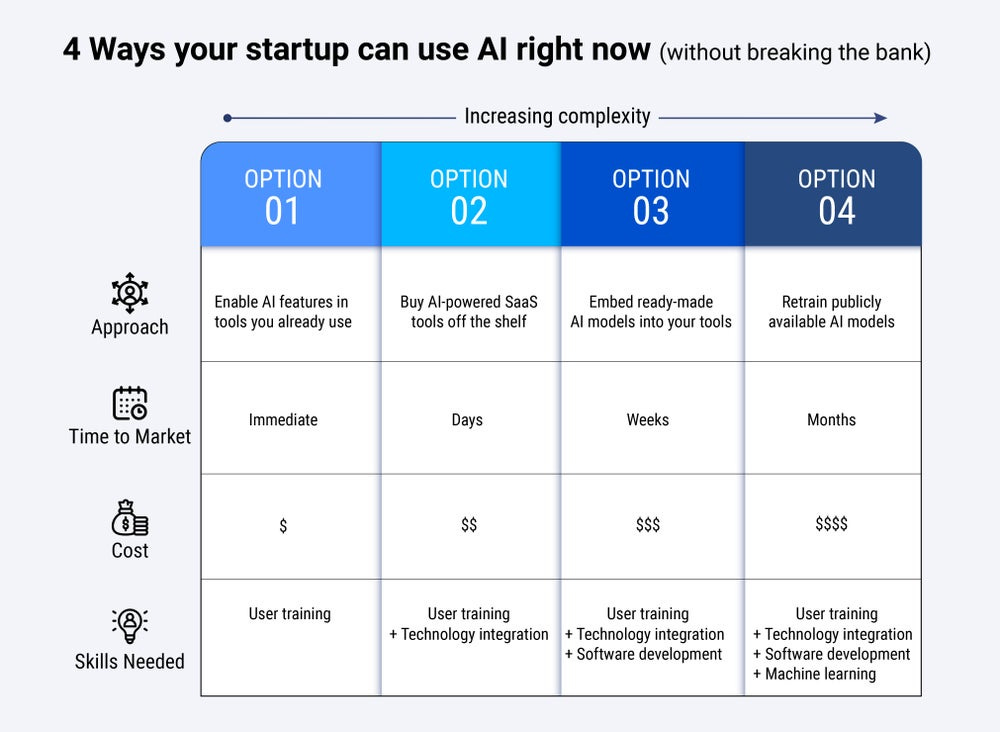4 Ways you can use AI *today* without breaking the bank🏦
Hello,
This newsletter will take you about 4 minutes to read.
I. Spotlight: 4 Ways you can use AI *today* without breaking the bank🏦
Despite its abilities and appeal, AI is not a fit for every situation. There are five scenarios where you should stay away from the technology.
However, there are situations that warrant the horsepower of AI. In those cases, the additional intelligence and automation can be transformational for your business. That’s where you should really double down on your efforts to become AI-driven.
“But, do I really need a big budget to use AI?” is a common question that leaders often grapple with.
No, your business doesn’t need months of effort, elite data scientists, or even big-ticket budgets to become AI-driven.
Here are the four ways any organization, large or small can start using AI today. These suggestions are sequenced from the easiest to the hardest, so squeeze top-down and settle on your most optimal option:
(Photo by Mika Baumeister on Unsplash)
1. Enable AI features in tools you already use
AI is all around us. Your smartphone has at least a dozen apps that use AI. Most enterprise tools are adding AI-driven features to their products. For example, in Microsoft Excel, when you click on insights suggested by the Ideas panel, you are using AI.
Ask vendors if the software you’ve bought has AI capabilities. Chances are your existing toolset could already be AI-driven or enabled with a quick upgrade. While some firms bundle AI features into their core product offerings, others may need a top-up.
2. Buy AI-powered SaaS tools off the shelf
Today, an overabundance of SaaS (software as a service) tools are available at affordable monthly subscriptions. Do you want to polish your marketing copy? Grammarly’s nifty copy-editing features can help you cover good ground.
Scout for functional SaaS tools that are powered by intelligent capabilities. Most of them come with ready integrations and easily plug into your existing IT ecosystem. Even if they aren’t a perfect fit, what matters is whether they can solve a majority of your problems.
3. Embed ready-made AI models into your tools
When you can’t find AI-driven tools, the next best option is to look for AI models that your tools can connect to. For example, to spot manufacturing defects in your products, AI can automate the visual inspection. Amazon Lookout for Vision is a cloud machine learning (ML) service that directly plugs into your workflow.
Unlike the earlier steps, this one calls for DevOps (software development and IT operations) capability, though you don’t need data scientists yet. Look for online ML platforms that have pre-built AI models, such as AWS, Azure, or Clarifai.
(Picture: 4 ways to become AI-driven)
4. Retrain publicly available AI models
When you’ve exhausted the above options, it’s time to train AI models in-house using data scientists. However, rather than starting from scratch, you can save effort by reusing publicly available AI algorithms and training them on readily curated datasets.
The best things on the internet are often free, but finding them takes time. Look for open repositories such as HuggingFace that publish their models with pre-trained weights. Alternately, your teams can build upon the work of award-winning models in public contests such as Kaggle, DrivenData, or AICrowd.
This is an excerpt of my latest article on Entrepreneur. For more examples and tools for each of these 4 options, check out the full article.
II. Industry Roundup:
1. Podcast: How AI helped accelerate Moderna’s COVID-19 vaccine
20 minutes | MIT Sloan Management Review | Me, Myself, and AI
Unlike large pharma companies, Moderna was carefully built with a digital-first culture from inception. Not surprisingly, this 10-year old company came up with the blueprint for the COVID vaccine in just 2 days. Moderna’s Chief Data and AI officer, Dave Johnson shares the biotech firm’s platform approach to drug discovery.
2. Article: How data creates trillion-dollar firms: The case of Domino’s Pizza
6 minutes | Forbes | Steve Denning
Domino’s Pizza crafted its turnaround story by famously pivoting into a ‘tech company that happens to sell pizza’. But in the digital age, the challenge for the pizza maker might have just begun. “Domino’s real long-term competitor isn’t Papa John’s: it’s Door Dash,” says this article. “The company’s chance of turning into a long-term winner will depend on data more than pizza,” it reveals. What turns companies across categories into competitors and how can data help them survive? Read on.
III. From my Desk:
1. Podcast: Building a company that helps clients become data-driven
39 minutes | Bedrock Podcast
What's the problem we set out to solve when we started Gramener? In this podcast, I talk about the business challenges we focussed on and how our journey evolved over the years.
2. Webinar Video: 5 Steps to measure ROI from your data science initiatives
45 minutes | Gramener
Are you getting value from data? Surprisingly, not many companies track this. Those who do, find it difficult to quantify their ROI. What's the best way to measure ROI from analytics? This webinar walks through the process with an example.
What’s in a name? Ask Corona beer and Delta airlines! While you’re at it, don’t miss this sweet story of how Delta airlines cheered up their 3-year-old-namesake!
Thank you for subscribing and reading the newsletter. I appreciate your attention,
Ganes.
PS: Did someone forward this to you? You can subscribe here.
My Website | LinkedIn | Twitter | YouTube
I’m Ganes Kesari. I publish ‘Data-Driven Future’ to help understand how data shapes our world, explore key trends, and explain what they mean for you today. I speak and write to demystify data science for decision-makers and organizations.
Recent Issues:








